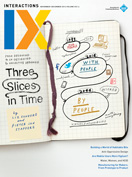Authors:
Joanna Dauner, Emre Karagozler, Matthew Glisson, Chris Speed, Mark Hartswood, Eric Laurier, Siobhan Magee, Fionn Tynan-O'Mahony, Martin de Jode, Andrew Hudson-Smith, Jiffer Harriman, Anna Feit, Antti Oulasvirta
Electric Flora is an installation that creates interactivity by harvesting electrostatic energy from the human body to generate light choreographies. The user produces electrical charge with the friction of their feet on the floor. Wearing Teflon shoes amplifies the charge. Every time the user gets in contact with a single electric plant (an acrylic tube with embedded LEDs), the electrical charge from the body activates the lights. In this way we generate interactivity without using any power sources other than the human body.
http://www.joannadauner.de/electricflora
Dauner, J., Glisson, M., Karagozler, M., Electric Flora: An interactive energy harvesting installation. Proc. of the 2014 Companion Publication on Designing Interactive Systems. ACM, New York, 2014, 125–128.
Joanna Maria Dauner, University of Arts, Berlin
[email protected]
Emre Karagozler, Disney Research, Pittsburgh
[email protected]
Matthew Glisson, Disney Research, Pittsburgh
[email protected]
Secondhand retail in the U.K. charity sector plays a number of important social and economic roles: Charity shops are community focal points; money is generated for good causes; and goods are recirculated that might otherwise be discarded. However, like much of the U.K.'s retail shops, the prosperity of charity shops is under significant threat from the rise of Internet shopping. Access to online markets via smartphones equips customers to check prices for secondhand items; some customers then use that information to haggle with shop staff. The Haggle-O-Tron is an interactive kettle placed in an Oxfam secondhand shop that playfully subverts both normative and emerging secondhand retail valuation practices by revealing secondhand goods' financial, moral, social, and aesthetic properties.
Chris Speed, University of Edinburgh
Mark Hartswood, University of Edinburgh
Eric Laurier, University of Edinburgh
Siobhan Magee, University of Edinburgh
Fionn Tynan-O'Mahony, University of Edinburgh
Martin de Jode, University College London
Andrew Hudson-Smith, University College London
http://www.iosht.org/dis_2014.html
Speed C., Hartswood, M., Laurier, E., Magee, S., de Jode, M., and Hudson-Smith, A. The Haggle-O-Tron: Design intervention in secondhand retail. Proc. of the 2014 Companion Publication on Designing Interactive Systems. ACM, New York, 2014, 137–140.
 |
An interactive kettle mimics the negotiation process between a vendor and a customer. |
Modular-Muse is a hardware and software toolkit for music. It is an exploration of design tools between off-the-shelf interfaces and digital-audio workstation (DAW) environments and common maker tools. It features input modules for interface design and output modules for physical sound actuation and controlling lights, as well as a software library to streamline sound design and hardware interaction. By offering an accessible and transparent platform that enables exploration in a creative context, Modular-Muse is a powerful tool for engaging users in higher levels of design thinking and offers a new context in which to explore electronics and programming.
Website: http://www.modular-muse.com
Harriman, J. Modular-Mus: Toward an interaction design toolkit for music. Proc. of the 2014 Companion Publication on Designing Interactive Systems. ACM, New York, 2014, 141–144.
Jiffer Harriman, University of Colorado
[email protected]
 |
The Modular-Muse interface board shown with connected I/O. |
In our search for faster text-entry systems, we were inspired by the high keying rates of skilled pianists, which are more than twice as fast as typists. We developed PianoText, which allows text entry on any MIDI-enabled piano keyboard. A computationally designed mapping assigns letter sequences of English to frequent note transitions in music, based on four concepts: redundancy, chords, sound feedback, and skill transfer. Our studies show text-entry rates of over 80 wpm and we estimate expert performance rates of 130-160 wpm. Our findings on those studies will inform the design of faster text-entry systems.
http://www.annafeit.de/pianotext
https://www.youtube.com/watch?v=-ykkTXo2Zyg#t=155
Feit, A., Oulasvirta, A. PianoText: Redesigning the piano keyboard for text entry. Proc. of the ACM Conference on Designing Interactive Systems. ACM, New York, 2014, 1045–1054.
Feit, A. and Oulasvirta, A. PianoText: Transferring musical expertise to text entry. Extended Abstracts on Human Factors in Computing Systems. ACM, New York, 2013, 3043–3046.
Anna Maria Feit, Max-Planck Institute for Informatics and Saarland University
[email protected]
Antti Oulasvirta, Aalto University
[email protected]
 |
PianoText (here shown in a portable form factor) allows text entry on any MIDI-capable piano. |
©2014 ACM 1072-5220/14/11 $15.00
Permission to make digital or hard copies of all or part of this work for personal or classroom use is granted without fee provided that copies are not made or distributed for profit or commercial advantage and that copies bear this notice and the full citation on the first page. To copy otherwise, to republish, to post on servers or to redistribute to lists, requires prior specific permission and/or a fee.
The Digital Library is published by the Association for Computing Machinery. Copyright © 2014 ACM, Inc.









Post Comment
No Comments Found